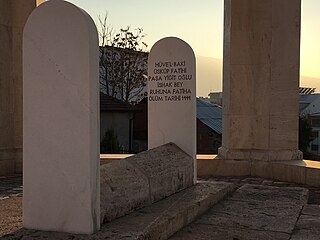 W
WHusein Gradaščević was a Bosnian military commander who later led a rebellion against the Ottoman government, seeking autonomy for Bosnia. Born into a Muslim Bosniak noble family, Gradaščević became the captain of Gradačac in the early 1820s, succeeding his relatives at the position. He grew up surrounded by a political climate of turmoil in the western reaches of the Ottoman Empire. With the Russo-Turkish war (1828–29), Gradaščević's importance rose; the Bosnian governor gave him the task of mobilizing an army between the Drina and Vrbas. By 1830, Gradaščević became the spokesperson of all Ottoman captains in Bosnia, and coordinated the defense in light of a possible Serbian invasion. Sparked by Ottoman Sultan Mahmud II's reforms that abolished the Janissaries and weakened the privileges of the nobility, and the autonomy and territory granted to the Principality of Serbia, much of the Bosnian nobility united and revolted. Gradaščević was chosen as the leader, and claimed the title of Vizier. This uprising, with goals of autonomy, lasted three years and included termination of Ottoman loyals mainly in Herzegovina. Among notable accomplishments, Gradaščević led forces victorious against the Ottoman field marshal in Kosovo. The uprising failed, while all captaincies were abolished by 1835. Temporarily exiled in Austria, he negotiated his return with the Sultan and was allowed to enter all of the Ottoman Empire except Bosnia. He died under controversial circumstances in 1834 and was buried in the Eyüp Cemetery in Istanbul.
 W
WGazi Husrev-beg was an Ottoman sanjak-bey (governor) of the Sanjak of Bosnia in 1521–1525, 1526–1534, and 1536–1541. He was known for his major contribution to the improvement of the structural development of Sarajevo urban area and his construction of many important buildings there, such as the Gazi Husrev-beg Mosque or the medresa Kuršumlija, as well as for his successful conquests and for the launching of further Ottoman expansion into Croatia.
 W
WIsa-Beg Ishaković was an Ottoman general and the governor of the Sanjak of Bosnia for most of his career. Of Bosnian noble origin, he was recruited after being held hostage by the Ottomans. He was a provincial governor during the 1450s and 1460s, first in charge of the Sanjak of Skopje, and then the Sanjak of Bosnia. He was instrumental in the Ottoman conquests in the region, and was one of the Sultan's most trusted generals.
 W
WIshak Bey or Ishak-Beg was an Ottoman governor and soldier, the sanjakbey of Üsküb from 1415 to 1439.
 W
WMehmed-beg Kapetanović Ljubušak was a Bosnian writer and public official.
 W
WThe Miloradović or Hrabren (Храбрен) or later Stjepanović (Стјепановић), were a Eastern Orthodox Vlach noble family and a katun clan from Hum, parts of present-day of Herzegovina,. whose some later branches embraced Serb ethnic identity, while other converted to Islam. The members of the family served the Kingdom of Bosnia, Republic of Ragusa, Ottoman Empire.
 W
WFerhad Pasha Sokolović was an Ottoman general and statesman from Bosnia. He was the last sanjak-bey of Bosnia and first beylerbey of Bosnia.